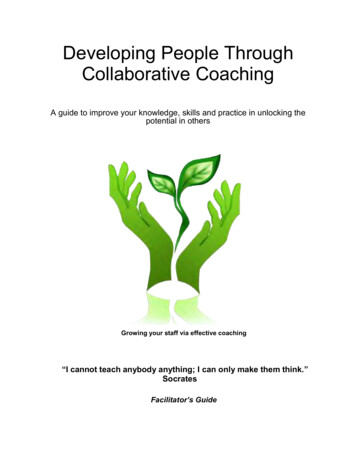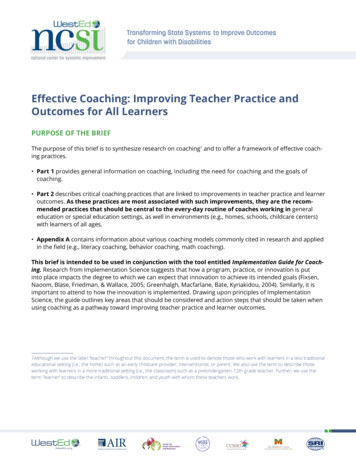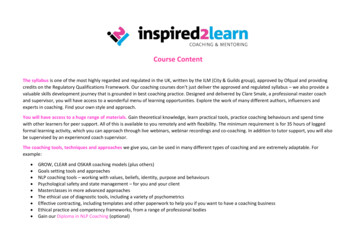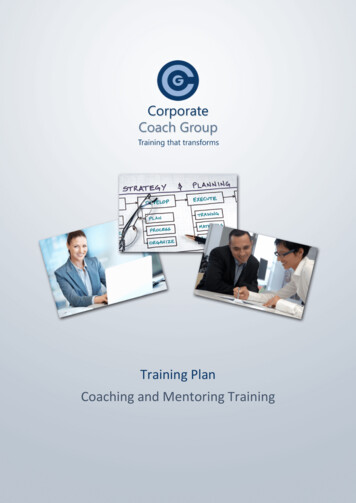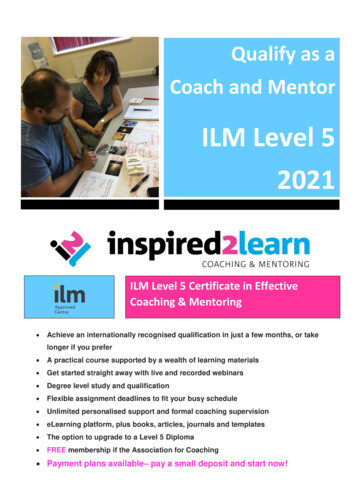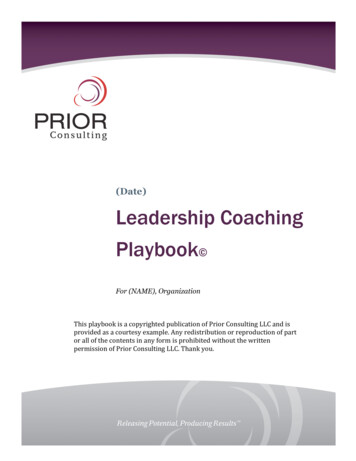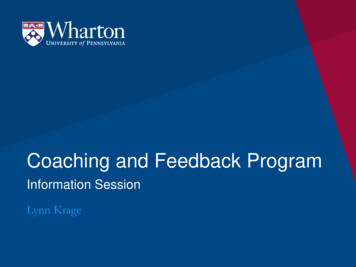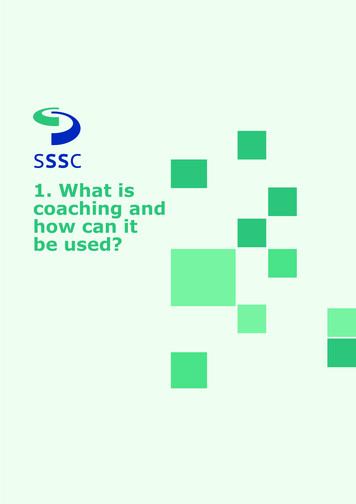
Transcription
1. What iscoaching andhow can itbe used?Coaching Learning Resource 7
In this section we cover:1.2.3.what is coaching and why it is useful in social serviceshow a coaching approach can be used in different wayswhat is involved in an informal coaching approach.After reading this section you will be able to: describe what is involved in coaching and how it can be used show what coaching in practice looks like in the social service context consider what the potential roles in coaching might mean for your ownpractice.1.1 What is coaching and why it is useful in social servicesWhat is coaching?Coaching is a developmental approach to working and interacting with other people.It can help people develop their personal capabilities, interpersonal skills and capacityto understand and empathise with others. In turn, this can help people understandmore about their own challenges and make informed choices about their future. It canstrengthen their ability to use a range of influencing and leadership styles. Coachingcan help people feel more empowered to make a difference and improve their owneffectiveness.‘We believe that coaching is a practical strategy that helps someone achieve outcomesthey identify themselves. The outcomes may be about perceptions and beliefs aswell as about observable behaviour and concrete action. Coaching leads to insight,discovery and forward movement, in alignment with the uniqueness of the individual,their understanding of the world, values and preferences. Relationship is thefoundation of its success.’(Jenny Bird and Sarah Gornall, 2016, p13)Why is coaching useful in social services?The vision for Scotland’s social services is for: ‘a socially just Scotland with excellent social services delivered by a skilled andvalued workforce which works with others to empower, support and protect people,with a focus on prevention, early intervention and enablement.’(Scottish Government, 2015, p7)Delivering this vision means supporting people using services to develop theirpersonal capabilities so they are able to exercise their citizen leadership to best effect(Scottish Government, 2008). It means having a workforce with the interpersonalskills and leadership capabilities to work with different people in different ways.8 Coaching Learning Resource
It means developing the culture across social services so people feel valued,empowered, enabled, inspired, motivated and able to see and take opportunities to dothings differently. It means making sure the culture continues to be supported by thecore social service values of: promoting enablement and participationunderstanding each individual in the context of family and communityidentifying and building on the strengths of individuals and communities.(Scottish Government, 2015, p11)If lots of people across social services are using a coaching approach more oftenthis will start to have a broader impact on service and organisational culture. Aculture in which people listen, demonstrate care and compassion, stay open toothers’ perspectives and new possibilities is consistent with the achievement ofSocial Services in Scotland – a shared vision and strategy 2015 – 2020 (ScottishGovernment, 2015). The development of a coaching culture will also enableindividuals to develop their own capacity to self-coach.‘Organisations wishing to maximise the benefits of coaching should focus onincreasing its scope and availability to create a coaching culture that permeatesthroughout their workforce. This means that coaching must be supported at the verytop of the organisation, but not limited to senior executives, and that organisationsneed to devote resources to developing their internal coaching capability.’(Institute of Leadership and Management, 2011, p2)The typical benefits of coaching for individuals include: improvements in communication and interpersonal skillsdevelopment of leadership and management capabilitiesfinding sustainable solutions to personal and work-related issuesenhanced capacity to resolve conflictpositive changes in attitudes and motivationincreased personal confidenceimproved management performancefeeling more engaged, valued and supportedfeeling more prepared for a change in role or organisational change.Coaching Learning Resource 9
1.2 How a coaching approach can be used in different waysA coaching approach can be used in different ways ranging from informal to moreformal as shown in diagram A. It can take place between two people or in groups ofpeople.Diagram A: Range of uses of coachingAn informal coaching conversation between two people or a group of peopleWe can use a coaching approach informally for better conversations between peopleusing services and between colleagues who work in social services. If you want tosupport others and yourself to step back and see things differently, you might considerusing a coaching conversation.The purpose of a coaching conversation is to encourage thinking and reflection. It cancreate the opportunity for people to see things from a fresh perspective. This can helpthem develop their capabilities, make sense of their situation and make clear choicesabout what to do next.A coaching conversation has different qualities to everyday social or work basedconversations. It differs in the quality of the listening and the space it providesfor those involved. The quality of this space can help people make sense of theirsituation and make clear choices about what to do next. It requires listening to eachother more intently, using open questions and avoiding jumping too quickly to ourown conclusions. In this way, you will help the other person see their situation moreclearly.It means staying open for longer to the possibilities being explored in the conversationrather than simply sticking to our own point of view. It means being able torecognise the difference between what is actually being said and our perceptions orassumptions about what is being said (or not). It can help groups of people work morecollaboratively and come up with new approaches together.10 Coaching Learning Resource
Example of using informal coachingA group of people working in social services want to find new ways of managingand developing a particular service. They decide to use a number of groupcoaching conversations. Through their coaching conversations, the group is ableto step back from their current situation and develop new insights. The space forreflection helps them to identify some improvements and make choices aboutnew ways of working.An informal coaching approach between line manager and workerManagers and workers in social services can make their working relationships moreeffective if they use a coaching approach. A line manager can enable a worker toidentify their own issues and come up with their own solutions rather than imposingsolutions on them by having coaching conversations. Central to a coaching approach isproviding timely, clear and specific feedback.‘A coaching conversation is unlike most other discussions. It involves an unusuallyhigh level of trust and candour on both sides.’(Jenny Rogers, 2004, p27)Leaders at all levels of social services use coaching as one of a range ofleadership stylesA coaching approach to leadership means the leader’s focus is on enabling otherpeople to develop their capabilities and find their own solutions. It means listeningmore and trying to understand points of view rather than imposing your own viewsand approaches.Coaching can also provide valuable support and challenge to people who are in formaland/or informal leadership roles by helping them explore their issues and concerns ina safe, supportive way.There is a clear link between using a coaching approach in leadership and the leadership capabilities outlined in the Strategy for developing leadership capacity in Scotland’s social services, 2013-2015 (Scottish Social Services Council, 2014).Formal coachingFormal coaching can be used for learning, development or performance improvement.The purpose of the coaching is agreed between the person being coached (coachee)and their coach. The coach discusses and agrees a contract with the coachee, whichincludes the focus or purpose of the coaching, the coaching process and how theboundaries around the coaching will be managed.Coaching Learning Resource 11
It can be one-to-one between a coachee and an internal coach working in socialservices who has undertaken formal development as a coach. Alternatively, it canbe one-to-one between a coachee and a coach who works external to the coachee’sorganisation and is formally qualified as a coach. It can also be with a team or groupof people who are being facilitated by an internal or external team coach (or team ofcoaches).See section 3 for a further explanation of the formal applications of coaching and howto practice as a formal coach.1.3 What is involved in an informal coaching approach?Values and behavioursIn an informal coaching approach, you have the positive intent to focus on the otherperson, on their strengths and their challenges and on the qualities they bring. Usinga coaching approach is about providing the space in which you and others are able toreflect and understand more about each other’s points of view. A genuine coachingapproach is based on trust and mutual respect.Core coaching skillsFor a coaching approach, you need to use a core set of coaching skills. Attending to the other person involved in a coaching conversation, building rapportwith them and seeking to understand what is going on for them.Listening carefully to the other person and paying attention to what they aresaying and how they are saying it.Summarising or paraphrasing what the other person has said as a way of helpingthem reflect on their own situation, rather than giving advice or adding in your ownjudgement.Using open questions which encourage the other person to say more, to reflect andunderstand more about their own situation.Being prepared to give honest, clear and specific feedback while making sure therelationship stays positive and open.What are the roles in informal coaching?The people involved in a coaching conversation are equals. In an informal coachingapproach, any or all of the people involved might take on the coach role at differentpoints. The coach role involves supporting the other person (or people) by makingskillful use of listening, summarising, open questions and feedback.Everyone involved in a coaching conversation needs to pay attention to creating theright conditions of trust, mutual respect, and positive intent. They need to be aware of12 Coaching Learning Resource
the importance of the core skills for coaching and be willing to develop their ability touse these skills.It is important to be clear about the purpose and nature of a coaching conversationand it is the choice for the person (or people) involved. At the start it is helpful forthose involved to be clear about what they are hoping to get from the conversation.This clarity about expectations will help everyone make the most useful contribution.The coach will not typically provide advice or solutions to the person (or people)being coached. This might feel strange at first and it is important to acknowledge thedifference.Being clear about the boundaries of a coaching conversation is particularlyimportant when it is taking place between a line manager and a member of hisor her team. Both people need to be clear about the purpose of the coaching. Forexample, if the coaching conversation is taking place as part of the performancemanagement process, the line manager has a particular responsibility for assessingthe performance of the individual and this will change the nature of the coachingconversation. On the other hand, it is possible for a line manager to have a coachingconversation with a member of his or her team which is purely developmental infocus.For more practical information on the values and behaviours, core skills, and theprocess for an informal coaching approach see section 2.Coaching Learning Resource 13
Using coaching skills informally: a practice case fromGowrie CareBackgroundFrontline workers in Gowrie Care were feeling challenged by having to explainthe company’s processes and ways of working to new recruits. They were keento support their colleagues but the rate of staff turnover meant they wereexperiencing an almost constant pressure to solve practical problems for newteam members. A high turnover of staff in social care is not uncommon and it isimportant for new workers to understand the care setting and ways of working.ApproachAs Learning and Development Officer, I was asked to deliver a ‘bite-sized’introduction to coaching skills course for this group of frontline workers. Thegroup was made up of 23 assistant support workers and support workers andone assistant manager. During the three hour session, I introduced them to theconcept of coaching and gave them a chance to practise their coaching skillsthrough the application of a simple coaching model based on GROW (see note*).At first, some participants were nervous and not sure what to expect. Graduallyduring the session they began to relax and feel relieved when they realisedthey don’t have to have all the answers. Many of them understood how similarcoaching skills are to the caring skills they use in their daily work. By using acoaching approach, they are able to provide support while enabling their newercolleagues to understand more and find their own answers to the challengesthey are facing. At its heart, a coaching approach is empowering for the newmembers of staff and supports them to take responsibility for their own learningand development. It also helps build rapport and positive working relationshipsbetween workers.ImpactThe aim of the coaching skills course was to explain the potential value of acoaching approach for staff in their interactions with new workers. By the endof the course, participants understood this potential. Using a coaching approachmay take more time at first but it has longer term positive impact for the learningof the individuals involved. Participants also realised the potential of using goodlistening and questioning skills in their day-to-day practice with people usingservices to help them address and solve their own issues in a self-directed andsupported way. There are plans to run further introduction to coaching sessionsopen to workers at all levels in the organisation.Senior Learning and Development Officer, Hillcrest Group of Companieswww.hillcrest.org.uk*Note: for more information on the GROW model see resource 1 and references inresource 2.14 Coaching Learning Resource
What to expect from coaching: a practice case fromTurning Point ScotlandBackgroundTurning Point Scotland is a national social care organisation that provides careand support to adults with complex needs. There is a richness and diversity toour work extending across learning disability, substance misuse, homelessness,mental health and criminal justice. Our whole focus is about being person-centredand empowering people to live their lives to the best of their ability.ApproachCentral to achieving high quality support with people is to make sure staff areequipped with the right values and supported with the right skill sets for theirwork. Coaching is key to achieving this across the organisation. It is part of ourDNA to coach people, to support them, to enable them to achieve things or findsolutions for themselves.By promoting a coaching approach in our staff learning, we feel staff have theopportunity to show leadership capabilities and behaviours at all levels. Coachinglends itself to having a major impact on motivating, inspiring and empoweringpeople.Testimony to the organisation’s top to bottom approach comes from one of ourservice managers.‘Being positive about coaching helps to underpin the values and principles weimplement in social care. I see it day in and day out in the way staff support eachother and how they support the people we work with. It just feels like the rightway to do things’.Examples of coaching practice1. In our courses for making the most of and offering effective supervision wehave included sections on coaching to help develop and empower staff in howthey approach working with colleagues. The vast majority of frontline andsupervisory staff will attend these courses. We also run bespoke coachingworkshops in some services.2. Coaching is a key element of our Gateway to Leadership Programme for servicemanagers and functional managers. This looks at learning styles, coachingquestions, coaching models and encourages reflection on real examples thatpeople bring to the course. There is also one-to-one coaching input from ahighly respected external organisation which really gets people thinking aboutwhat they need to do next in their own development.Head of Learning and Quality, Business Development and Improvement Team,Turning Point Scotland www.turningpointscotland.comCoaching Learning Resource 15
What to expect from coaching: experiences fromcoaches and coachees in the Scottish CoachingCollaborative (Workforce Scotland, 2014)The Scottish Coaching Collaborative interviewed some of their coaches andcoachees and invited them to share what coaching means to them. Watchthe interviews to learn a little bit more about how coaching is helping theseindividuals to develop insight.You will hear Helen Carlin, Chief Executive and Kirstie McGregor, Coordinator ofRowan Alba, talk about their experiences of coaching and being coached in RowanAlba.You will hear Sharon Millar, Leadership Consultant in NHS Education for Scotlandand Laurena Charles, Development Manager in Scottish Government, talk aboutthe potential of coaching supported by the Scottish Coaching Collaborative.You will also hear Jim Kerr, Governor of Shotts Prison, talk about his e xperienceof being coached.Scottish Coaching Collaborative developing insight videos.16 Coaching Learning Resource
Questions for reflection at the end of section 11. What do you understand about informal and more formal coachingapproaches?2. How do you think that having more coaching conversations might be helpfulto you in your role?3. What benefits do you think there might be if more people were having morecoaching conversations?For people using servicesFor people who work in social services4. What more do you want to know about coaching?Coaching Learning Resource 17
1.2 How a coaching approach can be used in different ways A coaching approach can be used in different ways ranging from informal to more formal as shown in diagram A. It can take place between two people or in groups of people. Diagram A: Range of uses of coaching An informal coaching
